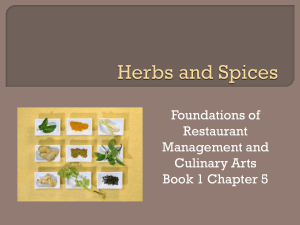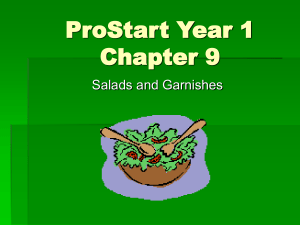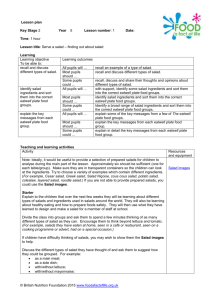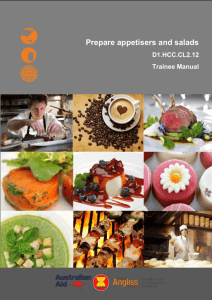Salads and Garnishes Four Basic Parts of Salad Base
advertisement
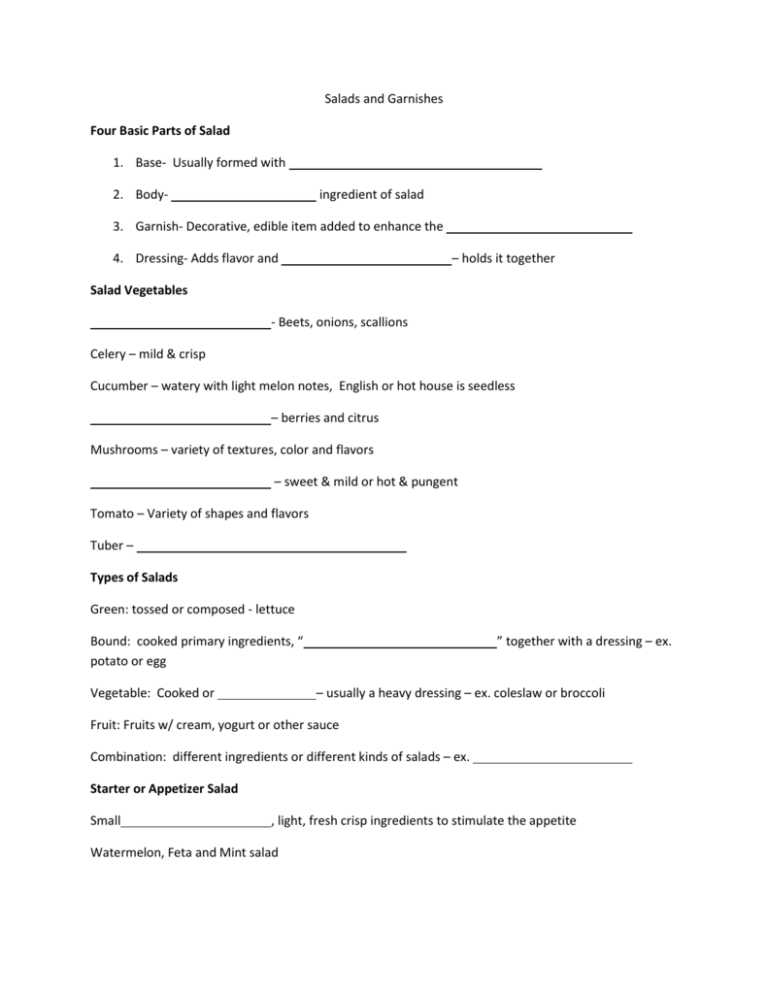
Salads and Garnishes Four Basic Parts of Salad 1. Base- Usually formed with 2. Body- ingredient of salad 3. Garnish- Decorative, edible item added to enhance the 4. Dressing- Adds flavor and – holds it together Salad Vegetables - Beets, onions, scallions Celery – mild & crisp Cucumber – watery with light melon notes, English or hot house is seedless – berries and citrus Mushrooms – variety of textures, color and flavors – sweet & mild or hot & pungent Tomato – Variety of shapes and flavors Tuber – Types of Salads Green: tossed or composed - lettuce Bound: cooked primary ingredients, “ potato or egg Vegetable: Cooked or ” together with a dressing – ex. – usually a heavy dressing – ex. coleslaw or broccoli Fruit: Fruits w/ cream, yogurt or other sauce Combination: different ingredients or different kinds of salads – ex. Starter or Appetizer Salad Small , light, fresh crisp ingredients to stimulate the appetite Watermelon, Feta and Mint salad Accompaniment or Side Salad Light and , but not too rich Should balance and the main course Ex. Potato, macaroni, or any side salad. Main Course Salad Large enough to serve as a Protein – well balanced visually and nutritionally Intermezzo Salad or Palate Cleanser--After a rich dinner dessert, very light Dessert Sweet, usually contains fruit and sometimes cream, pudding or yogurt as a sauce Cleaning & Preparing Greens Keep Clean thoroughly – dirt, insects, pesticides Remove core, outer leafs , don’t soak Dry – spin or Remove bad spots and tough stems – tear don’t cut Salad Dressings Vinaigrette – suspension is a temporary mixture of ingredients that then separates again. oil to part acid (vinegar or citrus juice). parts Emulsified Vinaigrette – using an emulsifier to permanently keep ingredients . Mayonnaise Based – like blue cheese, ranch or thousand island. Mayonnaise – Oil, vinegar, eggs – used as a binder in salad. Other – sour cream, yogurt, fruit juices, etc… Dips Flavorful mixture that accompanies certain food items. Served hot or cold. Good consistency is important. Garnishes ** Complements the food in , and . Essential Skills Always garnish dishes right before Purpose is to add to a plain dish Contrasting Herbs and Spices Herbs Leaves, stems or flowers of an aromatic plant Fresh or Dried Dried herbs are When using dried herbs crumble or crush them to Use Add fresh herbs at the than fresh flavor time more fresh then dried of cooking Spices Bark, roots, seeds, buds or berries of an aromatic plant. Usually dried – Might be fresh, such as ginger Store in tightly covered containers in place. Basil Italian Cooking Soups, Stews, Meats Use the Bay leaf, but before serving Chives Potatoes, Garnishes, Seafood, Soups Cilantro Food, Thai Food, Sauces, Dill Fish, Potatoes, , Dips, Carrots, Bread Lemon Grass Chicken, Seafood Mint , Lamb, Tea Oregano Italian Food, Mexican Food, , Spaghetti Parsley , Meat, Cheese, Salads, etc…. Rosemary , Seafood, Mushrooms, Vegetables Sage Pork, Turkey, Stuffing, Mushrooms Tarragon Chicken, , Mushroom, Seafood Thyme Meat, , Mushrooms, Nuts, Potatoes Allspice Tropical Evergreen Tree Berry Nutmeg, Cloves, Cinnamon Pickling, Stews, Caraway Apple, Pork, Sausage, Rye Bread Cayenne Any food, but can add lots of !! Chili Powder Blend of cumin, garlic, onion and Tex-Mex, BBQ Cloves Immature flower Meats, Stocks, Sauces, Baking Coriander Cilantro seeds Variety of cooking uses in savory and baked foods Cumin Seeds – used crushed Mexican Foods, Chili Ginger Root of plant Baking, Foods Nutmeg Seed kernel inside a fruit Baking, cheese, eggs, Alfredo Paprika Finely ground powder from dried pepper Garnish, salads, sausage, casseroles Peppercorn Dried unripe berry – black pepper, used in most foods Poppy Seeds From poppy flower Baking, Saffron Dried stigmas of crocus Most Mediterranean and Asian foods spice in the world Sesame Seeds Found in the pod of a tropical plant Baking, Tahini Paste, Asian Fish dishes Plate Presentation Why Is it Important?? Eating with your eyes Appearance Freshness What to look for? Shape Height Items Flavor S.C.H.I.F.T. Shape: Different shapes shows various knife skills and keep your guest wondering how it is made. Color: Color gives your plate a sense of freshness. It also indicates that you can control changes through heat (cooking techniques). Height: Incorporate the natural shape of food to provide varied, but not extreme, heights. This enhances the flow of food on the plate. Height creates on the plate. Items: Choose food items based on practicality, the plate. size, number of other items on Flavor: This is the single most enhance your presentation naturally. factor. Use only fresh, compatible flavors, to Texture: To achieve a variety of textures, different your cooking methods and apply to your vegetables to create variation. Functional Garnishes Use functional garnishes that make sense. Add texture or taste to the food Serves a , such as to add crispness for a contrasting texture. Harmonizes yet doesn’t from the focal point of plate. Functional versus Non Functional serviceability Harmony The with which guests can serve themselves from the plate or the platter. The layout on the plate should work as a cohesive unit. They should be unity among all the food being served. They should be harmony of ingredients and items on the plate. Focal point Contemporary approach to plating features the main item as the focal point, in the center, with the other items underneath or around it or scattered on the plate. Do not the plate, empty space will reinforce the focal point. Conclusion Good food, whether hot or cold, is a combination of fresh ingredients prepared in the proper way with simple layers of harmonizing flavors. Solid understanding of how to build flavor profile in order to present them with style is a must. Two great words from Master Chef Edward G. Leonard regarding plate presentation: SIMPLE AND ELEGANT

